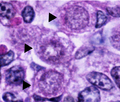Oogonium
Oogonium is the female germ cell involved in the production of mature oocytes or egg cells. It is a crucial part of the sexual reproduction process in many organisms, including humans.
Overview[edit]
An oogonium is the earliest stage of development in the female gametogenesis process. It is a diploid cell, meaning it contains two complete sets of chromosomes. Oogonia are formed during the embryonic development stage and are present at birth in female mammals.
Development[edit]
The development of an oogonium into a mature egg cell is a complex process that involves several stages. Initially, the oogonium undergoes a process of mitosis to increase its number. This is followed by meiosis, a type of cell division that reduces the number of chromosomes by half. The result of this process is the formation of a primary oocyte, which then develops into a secondary oocyte and finally into a mature egg cell.
Role in Reproduction[edit]
The primary role of the oogonium is to produce mature egg cells for reproduction. Each oogonium has the potential to develop into a mature egg cell that can be fertilized by a sperm cell to form a zygote, the first cell of a new organism.
In Other Organisms[edit]
While the process of oogonium development is similar in most organisms, there are some differences. For example, in plants, oogonia are found in the ovule and develop into egg cells through a similar process of mitosis and meiosis.
See Also[edit]

This article is a cell biology stub. You can help WikiMD by expanding it!
This reproductive system related article is a stub. You can help WikiMD by expanding it.
Oogonium[edit]
-
Oogonium in G0-G1 phase
-
Oogonium
Ad. Transform your life with W8MD's Budget GLP-1 injections from $75


W8MD offers a medical weight loss program to lose weight in Philadelphia. Our physician-supervised medical weight loss provides:
- Weight loss injections in NYC (generic and brand names):
- Zepbound / Mounjaro, Wegovy / Ozempic, Saxenda
- Most insurances accepted or discounted self-pay rates. We will obtain insurance prior authorizations if needed.
- Generic GLP1 weight loss injections from $75 for the starting dose.
- Also offer prescription weight loss medications including Phentermine, Qsymia, Diethylpropion, Contrave etc.
NYC weight loss doctor appointmentsNYC weight loss doctor appointments
Start your NYC weight loss journey today at our NYC medical weight loss and Philadelphia medical weight loss clinics.
- Call 718-946-5500 to lose weight in NYC or for medical weight loss in Philadelphia 215-676-2334.
- Tags:NYC medical weight loss, Philadelphia lose weight Zepbound NYC, Budget GLP1 weight loss injections, Wegovy Philadelphia, Wegovy NYC, Philadelphia medical weight loss, Brookly weight loss and Wegovy NYC
|
WikiMD's Wellness Encyclopedia |
| Let Food Be Thy Medicine Medicine Thy Food - Hippocrates |
Medical Disclaimer: WikiMD is not a substitute for professional medical advice. The information on WikiMD is provided as an information resource only, may be incorrect, outdated or misleading, and is not to be used or relied on for any diagnostic or treatment purposes. Please consult your health care provider before making any healthcare decisions or for guidance about a specific medical condition. WikiMD expressly disclaims responsibility, and shall have no liability, for any damages, loss, injury, or liability whatsoever suffered as a result of your reliance on the information contained in this site. By visiting this site you agree to the foregoing terms and conditions, which may from time to time be changed or supplemented by WikiMD. If you do not agree to the foregoing terms and conditions, you should not enter or use this site. See full disclaimer.
Credits:Most images are courtesy of Wikimedia commons, and templates, categories Wikipedia, licensed under CC BY SA or similar.
Translate this page: - East Asian
中文,
日本,
한국어,
South Asian
हिन्दी,
தமிழ்,
తెలుగు,
Urdu,
ಕನ್ನಡ,
Southeast Asian
Indonesian,
Vietnamese,
Thai,
မြန်မာဘာသာ,
বাংলা
European
español,
Deutsch,
français,
Greek,
português do Brasil,
polski,
română,
русский,
Nederlands,
norsk,
svenska,
suomi,
Italian
Middle Eastern & African
عربى,
Turkish,
Persian,
Hebrew,
Afrikaans,
isiZulu,
Kiswahili,
Other
Bulgarian,
Hungarian,
Czech,
Swedish,
മലയാളം,
मराठी,
ਪੰਜਾਬੀ,
ગુજરાતી,
Portuguese,
Ukrainian

